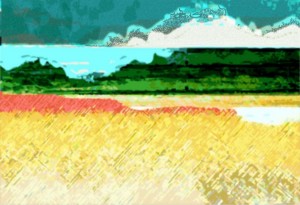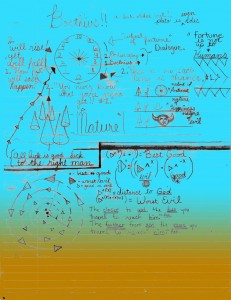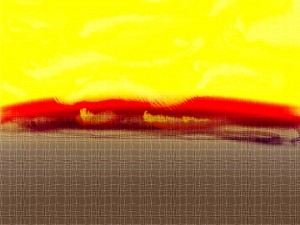Issue 28 11.20.13

A Human’s Job
By Tyson Frederick
It is a human’s job to be an artist. It is the artist’s job to think about an idea, to think about the self, to think about consciousness. When I think of process, it is the state or mode of being. There is a harmonic connection of the artist between material, idea, and application. At any relative point in an artist’s production and process, we can interpret the object as a perception of the artist. Upon this empathy, one can reflect on their own horizon lines of opinion and relate what is presented to them with what seems to be true.
The definition of “process” must encapsulate that feeling experienced while producing work. Artists’ acute awareness seems to be rather unique; artists can project and produce something that isn’t directly tangible. An artist’s creation is produced from conceptual thought and abstract thought. Knowledge (what the individual perceives in and as themselves) and the unknown (a phenomenal accumulation of things that have yet to be understood) are two great sources for artwork. These two qualities seem to be contraries. As an artist or viewer encounters something, be it known or unknown, they become more familiar or less familiar with what is seen in direct proximity by cuing old relationships and experiences that are most similar, to the point the object is understood or misunderstood in it’s own peculiar way by the viewer. This comfort or discomfort that arises in the manipulator or viewer creates a dynamic relationship with each artistic object and is a crucial interaction for understanding the artistic practice. Objects will be viewed with some sort of appearance or interpretation. Unfamiliarity often makes stronger impressions on the viewer because the event becomes exploratory rather then of recollection.
The method and the medium may be particular of each individual artist. Each artist’s idea of what it takes to develop is different, but there may be a commonality of the particular cases of each artist, a type of common framework that could be considered for understanding. This framework is the willingness to proceed under unexpected circumstances by making and arriving at a conscious choice. If the choice is to be unconscious in method and application, possibly resulting in abstraction, then so be it still by choice of the artist. Particular reasoning to the artist which address conceptual or aesthetic choice perhaps illuminate the truth of the matter within the artist and likewise, the resulted artwork.
Congregations of people develop artisan conceptuality. In this sense, it’s necessary to research influential ideas about creation in order to better understand reality’s hints at truthful perception. Everyday life is full of unknown truths; to communicate with those aspects of life grants opportunities of freedom from existing pattern and belief.
I’d like to think that through analysis of artistic process, we will expose a fine line between experience and fact. Artists are searching for everything new on a consistent basis. Within these frameworks, theorists and practitioners make enormous discoveries towards the in-depth and interconnected construction of reality to discover the abstract nature of each individual’s perceptions and how these individual perceptions can shed light on conceptions of what might be eventually known as a universal truth.


